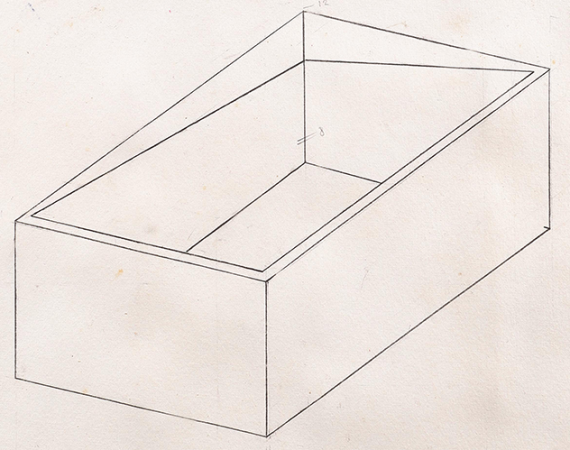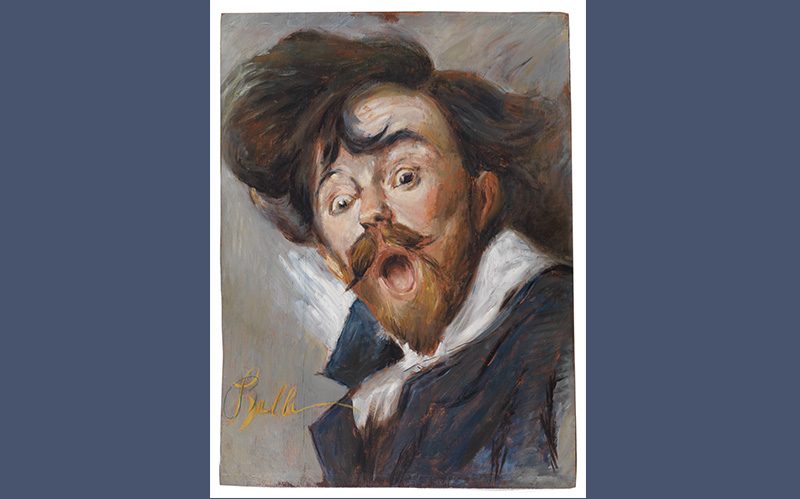
THE PAINTER BEFORE THE MIRROR
With his artwork “Autosmorfia”, which is to be auctioned at Dorotheum on the 4th of June, Giacomo Balla joins a long tradition of artistic self-representation and self-exploration. Art historian Giulia Tulino delves into the background of this exciting genre.
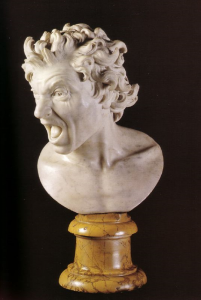
The interest in the psyche of the subject, which in the 16th century was culturally rooted in the pseudo-scientific themes of the day, the magical, the alchemical, and the physiognomic theories, were to take on a decisively more modern, rational, and scientific turn in the 17th century. The study of this rationality and of the movements of the human spirit thus began to characterise numerous portraits and self-portraits of the era. Gian Lorenzo Bernini’s work provides an expressive example of this and demonstrates notable immediacy and effective psychological introspection. Interior investigation and autobiographical reflection are also central elements in the work of European artists, particularly that of Rembrandt. On a par with Dürer, he tenaciously dedicated himself to self-portraiture, leaving 46 self-portraits, both drawn and painted, which condense all the strands typical of 16th-century production. It was these very pointed introspective self-portraits that conveyed Rembrandt’s growing suffering on canvas, which lent him the intuition to develop a new style defined by progressive disintegration in his brushstrokes and in the material which erased the traces of the sharp, bright precision of the paintings of his youth. It was this stylistic path that elicited the bafflement of his contemporaries and whose sole precedent was Titian’s “unfinished” (non finito) work. Rembrandt’s research draws the period of experimentation and classification of the self-portrait to a close, a period which lasted approximately from the 15th to the 17th century, and which conferred the genre with importance and autonomy within the European artistic tradition.
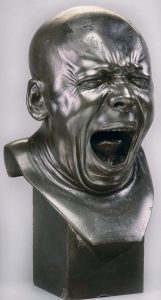
In the 18th century, we find an important encounter between art and psychology in the so-called “Character heads” of Franz Xaver Messerschmidt (1736–1783), which has been defined by Rudolf Wittkower as the “test bed for the study of problems relating to artists and insanity”. This is an almost unique case within the history of art, with a single precedent in the aforementioned Bernini, who created two character heads for Cardinal Foix De Montoya in 1619, titled “The Blessed Soul” and “The Damned Soul”. If Bernini’s intent was to study the human character and passions, Messerschmidt conveys the figure of a saturnine artist, extravagant and fatally absorbed in an individualistic and unshareable representation of reality, of himself, and of his art.
Among the artists of the 19th century we find various attempts to present the self-portrait in an organic context within the artist’s own career, so that the images of self and art coincide perfectly. Gustave Courbet’s “The Desperate Man, Self-portrait”, (1844–49) appears to convey a surprised awareness of the artist’s own appearance through the reflection of his image in the mirror, rendered with quasi-hyperrealist precision.
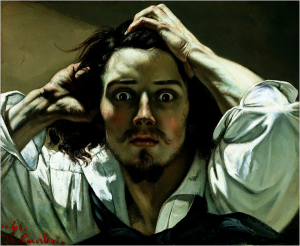
Developed by Sigmund Freud (1856–1939) in the early years of the 20th century, psychoanalysis was to give rise to an Oedipal turn in art, with subjective pictorial experiments which drew on regressive dreams and erotic fantasies. This development is evident in the work of Gustav Klimt, Egon Schiele and Oscar Kokoschka. Vienna at that time did not tolerate such experiments as they suggested a crisis in the stability of the self and of society, a crisis which enveloped more than just the Austrian capital, a situation which Freud was quick to analyse. Early 20th-century Italy also saw the birth of a more “human and genuine” art, particularly in the so-called “little Roman avant-garde” (Cena, Pellizza da Volpedo, Balla, Prini), inspired by contemporary reality and with a fundamental idealism tinged with sentimental and psychological accents, as well as a very intense humanitarian charge. This is the period in which Balla experimented with his “grimace” and its large tuft of red hair and bohemian neckerchief. The year was 1900, i.e. the year of the Paris Universal Exposition. The “City of Light” is more scintillating than ever. Young Giacomo Balla was 29 years old and had been in Paris since September as a guest of the artist Serafino Macchiati. “Let us try again … I go to Paris. There will be great art there, and one can learn from the great masters”, the painter wrote to his wife, Elisa. He visited the Louvre, where, among the canvases of Old Masters, he also came across the self-portrait of the Dutch artist Adrien Brouwer and “La haine et la folie” by Paško Vučetić. Writing once again to Elisa: “(…) After breakfast, I continued to paint heads pulling the most extravagant grimaces (they are SELF-GRIMACES), I will do several, and then try to sell them.”
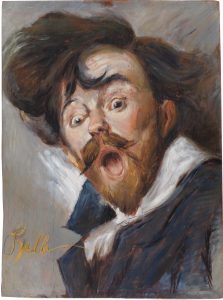
The “self-grimace” (“Autosmorfia”) is an image in motion which anticipates later experimental analyses such as a girl running on a balcony, the flight of the swallows or the speed of the car. But it is also somewhat different, as already attempted in a series of self-portraits (the first of which is rendered on the back of an earlier photo of himself) which, from 1894 on, explore the expressive potential of the human face.
Like other contemporary Italian artists painting self-portraits, Balla is also interested in the question of how he wants to represent himself, truth or lie, joy, or the visualisation of fears and hidden obsessions. The myth of Narcissus teaches us that one can be absolute fiction or unconscious truth, and that in the psychoanalytical picture the modern artist distinguishes himself from his predecessors by dismissing eternity in favour of consciousness and aspiring to know himself through self-portraiture.
INFORMATION about the AUCTION
Auction date: 4 June 2019, 5 p.m.
Location: Palais Dorotheum, Dorotheergasse 17, 1010 Vienna
Exhibition: from Saturday, 25 May











